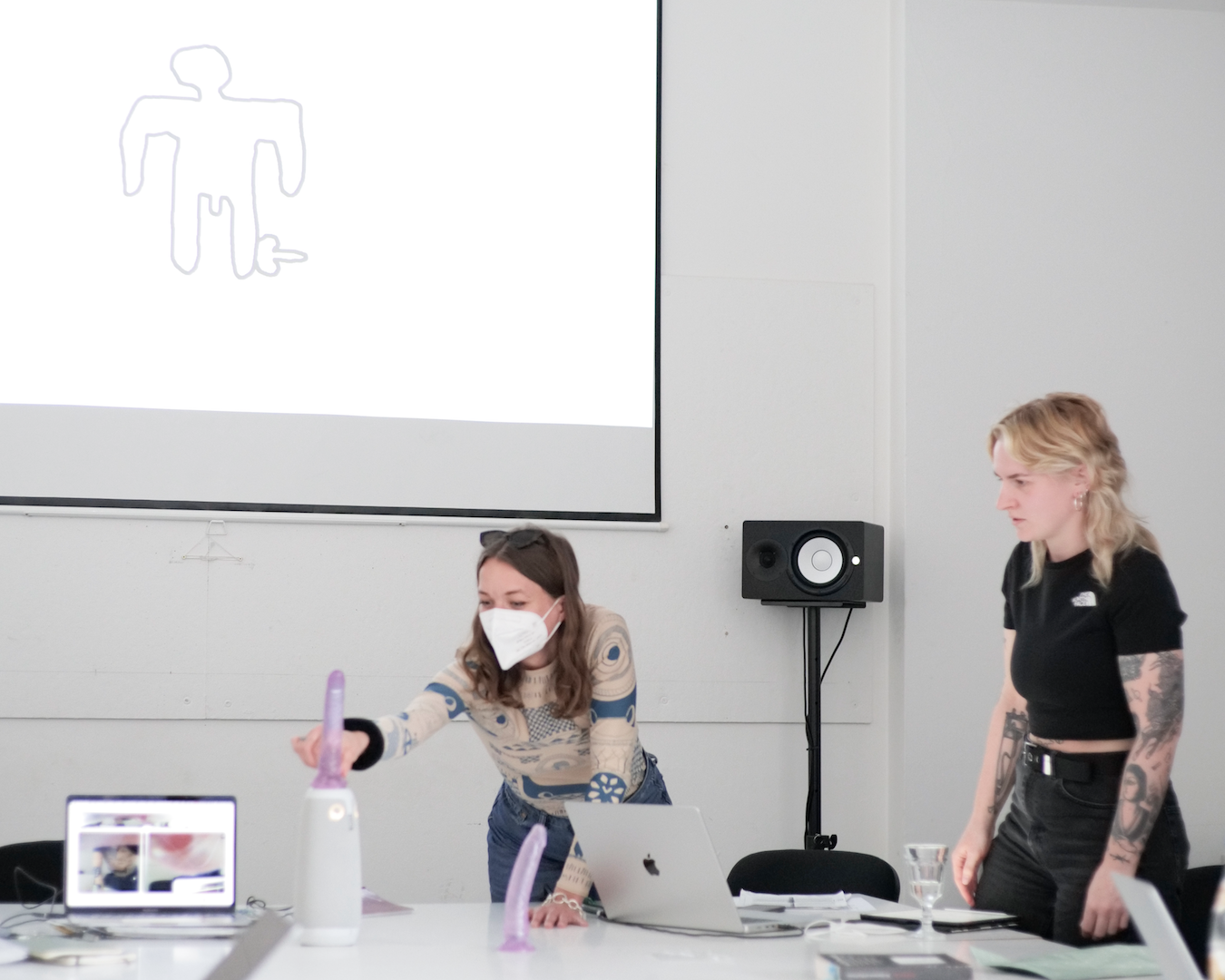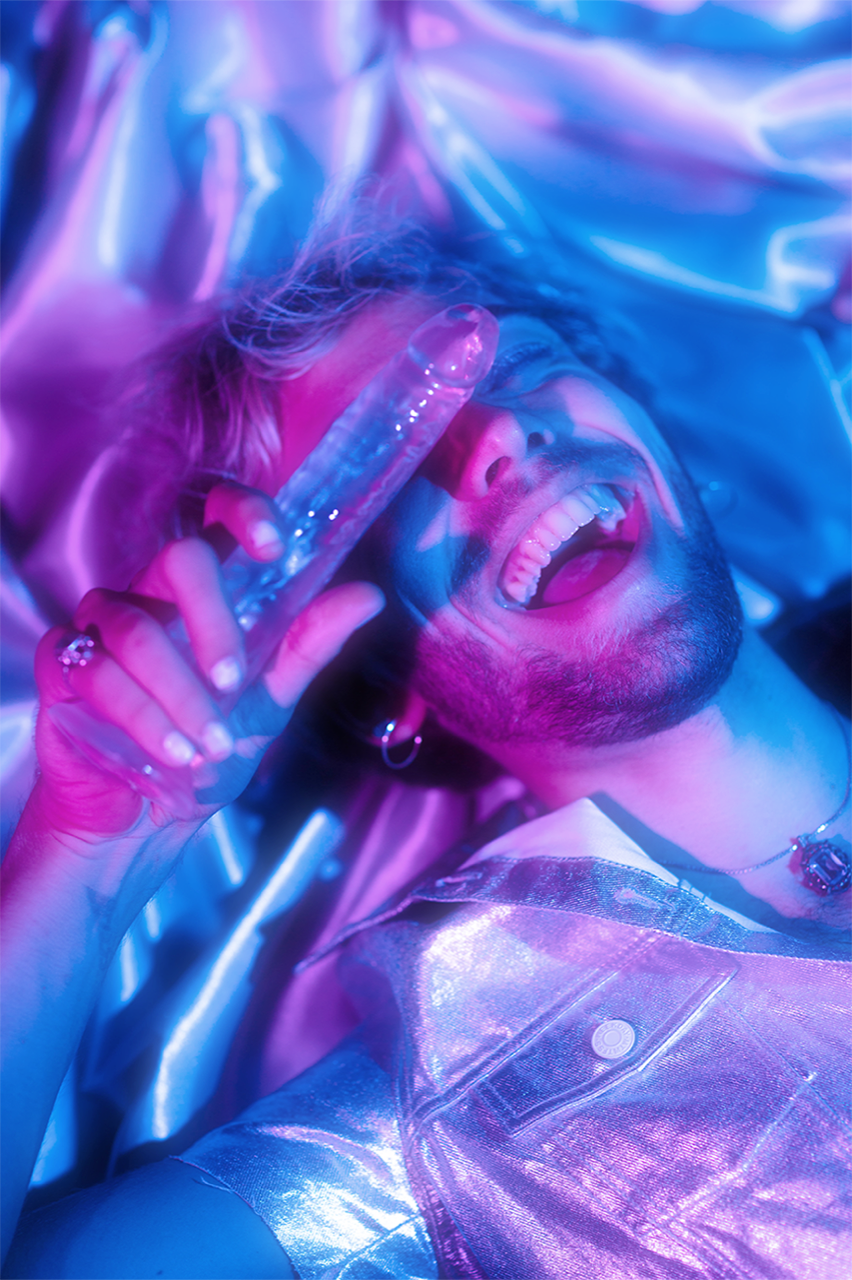Über die Verschiebung der Sexualität
Im Lektüreseminar „Queer-feministische Ästhetik“ fragen Paul B. Preciado und ich uns, ob Dildos, die einige Feministinnen als künstliche Nachbildungen des Penis und damit Symbole der patriarchalen Hegemonie bezeichnen, nicht eigentlich das exakte Gegenteil sind: inhärent queere Objekte, die sexuelle Machtstrukturen verschieben.
Schriftliche Ausarbeitung des Referats vom 20.05.2022 über „Die Logik des Dildos oder die Scheren Derridas“ in Paul B. Preciado: Kontrasexuelles Manifest. Berlin: b—books 2003. Entstanden im Lektüreseminar „Queer-feministische Ästhetik“ im Fachgebiet „Geschichte und Theorie der visuellen Kultur“ an der Fakultät Gestaltung der Universität der Künste Berlin, betreut durch Prof. Dr. Kathrin Peters.

Queer-feministische Ästhetik
Strukturelle Diskriminierung und Benachteiligung beschränkt sich nicht auf öffentliche und private Räume, sondern ist auch im professionellen Umfeld für viele Menschen tägliche Realität. Die Design- und Kunstwelt wurde – wie viele andere Bereiche der Gegenwart – innerhalb der patriarchalen Hegemonie konstruiert. Historisch gewachsene Regeln und Normen der Kunst und Gestaltung, sowie ihrer Rezeption orientieren sich an männlich konnotierten Fähigkeiten und Vorstellungen. Gestaltende mussten sich in vergangenen Jahrhunderten – insofern sie auf wirtschaftlichen Erfolg und Anerkennung hofften – entweder mit vorherrschenden Ideen identifizieren und ihre Regeln anerkennen oder sind der Kunstwelt gänzlich fern geblieben.1 Sich im 21. Jahrhundert in der Branche als nicht-cis-männliche:r Gestalter:in zu behaupten, ist noch immer eine tägliche Aufgabe, die herausfordert und persönliche feministische Positionierungen ins Wanken bringen kann.
Da weibliche Künstlerinnen weder in Museen, noch in Auktionshäusern annähernd so stark repräsentiert sind wie ihre männlichen Kollegen, sah sich das britische Auktionshaus Sotheby’s im Frühsommer 2021 berufen, die Online-Auktion „(Women) Artists“ anzubieten, um weiblicher Kunst der vergangenen 400 Jahre eine dezidierte Platform zu geben und Künstlerinnen der Gegenwart zu fördern.2 Marina Abramović konstatiert eine in der Branche herrschende „sehr große Ungerechtigkeit, da die Arbeiten von weiblichen Künstlerinnen unter ihrem Wert angeboten“3 werden. Dennoch nutzen Kunstschaffende und Gestaltende das Potenzial visueller Kultur – nicht nur als individuelle Ausdrucksform, sondern auch als Instrument im Kampf gegen Diskriminierung und Ausbeutung. Sich dabei von bestehenden normativen Vorstellungen zu lösen, stellt eine besondere Herausforderung dar.
„Im Film und in der Kunst müssen wir auch eine Sprache finden, die uns angemessen ist, die nicht schwarz oder weiß ist.“4 – Chantal Akerman
Das Lektüreseminar „Queer-feministische Ästhetik“ im Fachgebiet „Geschichte und Theorie der visuellen Kultur“ an der Fakultät Gestaltung der Universität der Künste Berlin beschäftigt sich mit der wechselseitigen Beziehung von Gestaltung und gesellschaftspolitischem Kontext. Wann ist Gestaltung feministisch, wann queer? Was macht queer-feministische Ästhetik formal aus und wer ist in der Lage, sie zu produzieren? Wer wird abgebildet und wer nicht? Kann sich Gestaltung, die in einer patriarchal dominierten Welt entsteht, überhaupt von ihr lösen?
„Die Möglichkeit einer anderen Erfahrung und Wahrnehmung der Weiblichkeit durch Frauen wurde als Infragestellung und indirekte Gefährdung männlichen Kunstschaffens häufig schon mit einbezogen.“5
Der binären Norm folgend, bezieht Feminismus traditionell eine oppositionelle Haltung zur patriarchalen Hegemonie, was diese – zum Leid aller feministischen Bewegungen – ständig wiederholt und erhält. Die Literaturwissenschaftlerin Teresa de Lauretis setzt in den späten 1980er und 1990er Jahren in der sog. „Queer Theory“ nicht nur unterschiedliche Diskriminierungsformen miteinander in Bezug und leistet damit einen maßgeblichen Beitrag zum intersektionalen Feminismus6, sondern beschreibt auch eine Kultur, die sich aus den Eigenschaften und Handlungen ihrer Mitglieder positiv konstituiert und nicht alleinige Gegenhaltung ist.7 Queerness funktioniert nur in der Selbstzuschreibung und definiert sich nicht durch klare Abgrenzungen, weshalb die inhaltliche Bedeutung des Begriffs immer wieder neu verhandelt werden kann und muss. Queer ist keine Opposition, ist nicht anti, sondern fluid und pluralistisch. Doch auch wenn in der nicht-binären Theorie keine gegenüberliegende Seite existiert, auf der ein Gegner verortet werden könnte, existiert er trotzdem auch in der Queer Theory: das Patriarchat.
Angst vor dem Dildo
Symbol des Patriarchats und der Männlichkeit im Allgemeinen ist unumstritten der Penis. Kein anderes menschliches oder nicht-menschliches Organ ist so stark aufgeladen mit Inhalten, wird stolz gezeigt, schamhaft versteckt, auf Schultische gekritzelt, als Foto verschickt, beneidet oder verschmäht. Der Penis ist das prunkvolle Siegelwappen der patriarchalen Vorherrschaft und zeitgleich das sensibelste Glied im organischen maskulinen Kettenhemd. Dass einige Lesben und andere Feministinnen daher Dildos, die in ihren Augen künstliche Nachbildungen des Penis sind, ablehnen, überrascht also kaum. Sie befürchten die (Wieder-)Einführung männlicher Vorherrschaft in ihre durch und durch feminine Sexualität. In den 1990er Jahren boykottierten einige feministische Buchläden in London den Verkauf von Del LaGrace Volcanos „Love Bites“, einer Sammlung von Fotografien, in denen u.a. eine Lesbe zu sehen ist, die einen Dildo leckt.8 Penetration? Ja bitte! Aber mit lesbischen Fingern, die fest mit dem lesbischen Körper verwachsen sind!

Nicht zu leugnen ist, dass Sextoys sich im Allgemeinen einer großen Beliebtheit erfreuen. Laut einer repräsentativen Studie der Technischen Universität Ilmenau, nutzen 52% der heterosexuellen Befragten zwischen 18 und 69 Jahren Sextoys mit Partner:innen. Bei der Masturbation sind es 72% der Frauen und 31% der Männer.9 Nicht repräsentative Studien legen nahe, dass die Zahlen unter queeren Personen nicht etwa geringer, sondern noch höher sind. Genaue Ergebnisse und wissenschaftliche Auseinandersetzungen bleiben jedoch aus. Der Zugang zum Dildo ist auch im wissenschaftlichen Kontext holprig und schambehaftet. Obwohl die Vorstellung von Paul Beatriz Preciados Text „Die Logik des Dildos oder die Scheren Derridas“, der Teil des „Kontrasexuellen Manifests“ ist, im Lektüreseminar „Queer-feministische Ästhetik“ durch mitgebrachte Objekte, Websites und humoristische Illustrationen niedrigschwellig und zwanglos gestaltet wurde, war die Beteiligung unter den Teilnehmenden eher gering und die Grundstimmung unsicher und angespannt.
Preciado denkt über die Bedeutung des Dildo nach und fragt: „Was ist ein Dildo?“10 Bildet der Dildo patriarchale Machtstrukturen im queeren Kontext ab? Ist er Projektion des maskulinen Begehrens auf die weibliche Sexualität? Welche Rolle spielt dabei seine Ästhetik und die Perspektive, aus der er betrachtet wird?

Preciado beschreibt im Text „Die Logik des Dildos oder die Scheren Derridas“ eine Szene aus Sheila MacLaughlins Film „She Must Be Seeing Things“ (1987), in der sich die Protagonistin Agatha in einen Sex-Shop begibt, um einen realistischen Dildo zu kaufen. Sie glaubt ihrer Geliebten damit zu gefallen. Beim Anblick des Dildo erkennt sie das zwischen Männern und Frauen herrschende Ungleichgewicht im Zugang zu Sexualität: aufblasbare Puppen – Nachbildungen des gesamten weiblichen Körpers – stehen Dildos – in ihren Augen plumpe Penis- Mimesen – gegenüber. Während männliche Sexualität durch den weiblichen Körper in seiner Ganzheit angesprochen wird, soll die weibliche Sexualität durch den Penis bzw. seine Nachbildung angeregt werden. Agatha entscheidet sich schließlich gegen den Kauf eines Dildos, dessen bloßer Anblick ihr zur Einsicht dieses Machtgefälles verholfen hat. Vielleicht befürchtet sie, dass das sexuelle Begehren ihrer Partnerin sich mit Verwendung des Dildos nur noch auf diesen beschränke und Agathas Körper fortan ausschließe. Preciado stellt fest, dass sich Agathas Sichtweise in diesem Moment der Konfrontation lesbischer Sexualität mit Heterosexualität durch den Dildo verändert und verweist auf Lauretis, die im Dildo einen kritischen, jedoch keinen praktischen Wert erkenne.11
Sowohl Agathas Erkenntnis, als auch Lauretis’ Analyse bauen auf der Annahme auf, dass „jeder Hetero-Sex […] phallisch und jeder phallische Sex […] hetero“12 sei: wenn zwischen Mann und Frau die Penetration durch den Penis ausbleibt, könne – egal wie intensiv die physische Auseinandersetzung ansonsten sein mag – nicht von Sex gesprochen werden. Sobald zwischen Personen ohne Penis penetrative sexuelle Handlungen stattfinden, sei die Referenz zum imaginierten Penis und damit dem Mann und damit dem Patriarchat hergestellt. Im angenommenen phallozentrischen Schema steht der Penis im Mittelpunkt jeglicher Sexualität und sexueller Handlungen. Neben zwischenmenschlichen Interaktionen, wird auch der singuläre weibliche Körper durch die Abwesenheit des Penis definiert. Die Misogynie dieses Denkmodells liegt auf der Hand. Lauretis bringt den Sachverhalt passend auf den Punkt: „Weibliche Sexualität wurde stets im Gegensatz und in Bezug auf männliche Sexualität definiert.“13
Durch die Kombination von Phallozentrik und Verwechslung des Penis mit der ihm zugeschriebenen patriarchalen Macht, ergeben sich sowohl für den Penis, als auch für den Dildo und letztlich die Sexualität selbst fatale Urteile. Diese Kette von Fehlannahmen zurückzuverfolgen, neu aufzuziehen und den eigentlichen Wert des Dildo zu erkennen, erscheint Preciado angebracht.
„Der Phallus ist nur eine Hypostasierung des Penis. Wie bei der Geschlechtsfeststellung intersexueller Babies deutlich wird, ist in der symbolischen heterosexuellen Ordnung der Signifikant par excellence nicht der Phallus sondern der Penis.“14
Schließlich enttarnt der Dildo den Penis und befreit ihn damit vom Gewicht des Phallus. Er offenbart, dass die assoziierte Macht eben kein angewachsenes Recht ist, sondern an jedem beliebigen Körper(-teil) umgeschnallt oder angesaugt werden kann. Sie ist ein Zepter, das beliebig von Hand zu Hand weitergereicht wird. „Der Dildo erscheint als exakte Nachahmung des Penis, bleibt aber vom männlichen Körper abgetrennt.“15 Es klingt wie das Horrorszenario eines jeden Mannes: das Glied ist abgetrennt und wird mal hier, mal dort benutzt, abgelegt oder im kochenden Wasser sterilisiert. Trotzdem ist es voll funktionsfähig – oder sogar noch praktikabler als der organische Referent. Kontrolle und Macht sind nicht angeboren, sondern werden egalitär weitergereicht und nach Lust und Laune eingesetzt. Preciado betont, dass jede:r einen Dildo benutzen und so genderbezogene phallische Machtstrukturen verschieben und in Frage stellen kann.
Vielleicht ist die Angst vor dem Dildo genau deshalb so groß. Die Anerkennung des Dildo als effektiver sexueller Technologie würde dem oder der Besitzer:in eines Penis vor Augen führen, dass ihr bestes Stück eben nur eines ist: ein sensibles Organ. Aber soll diese Erkenntnis nun als Degradierung verstanden werden oder könnte die Anerkennung seiner einzigartigen organischen Fähigkeiten und die gleichzeitige Akzeptanz der technischen Möglichkeiten des Dildo nicht eine Chance sein, die sowohl der Lesbe, als auch dem Hetero-Mann, als auch jeder anderen Person und ihrer Sexualität zugute käme?

Kontra-Sexualität
„The first twelve years or so I was very busy with trying to turn men on. […] and then after that it was like turn on other kinds of people, but not just in the genitals, but more the mind, the intellect, […] make them laugh, make them think, help them to learn something new“ – Annie Sprinkle16
Wahre Gleichberechtigung kann in jedem noch so kleinen Winkel des gesellschaftlichen Alltags nur bestehen, wenn sie auch dort Realität ist, wo Körper im vermeintlich Privaten und Intimen aufeinandertreffen: beim Sex. Tabus, Scham und Unsicherheit bieten den Nährboden für Gewalt und Missbrauch. Preciados Beitrag zu Gleichberechtigung, für die eine gesunde Sexualität unerlässlich erscheint, ist das Konzept der „Kontra-Sexualität“. Sie handelt „vom Ende der Natur, die als Ordnung verstanden wird und die Unterwerfung von Körpern durch andere Körper rechtfertigt“17. Preciado sieht Individuen nicht mehr als Mann oder Frau, sondern als Subjekte, die zu allen signifizierenden Praktiken gleichermaßen Zugang haben und untereinander gleichwertig sind.
Der Dildo sei das Werzeug der „systematischen Dekonstruktion sowohl der Naturalisierung der sexuellen Praktiken als auch der Geschlechterordnung“18. Dabei geht Preciado so weit, den Dildo als „Ursprung des Penis“19 zu bezeichnen. Diese Umkehrung der eingangs beschriebenen Annahme, der Dildo sei eine Nachahmung des Penis, begründet Preciado mit dem was Derrida als „gefährliches Supplement“ bezeichnet. Das Supplement, vereinfacht übersetzt als „Ergänzung“ oder „Zugabe“, fügt sich etwas hinzu oder setzt sich an die Stelle von etwas, zeigt aber auch die Lücke an, die es füllt. Der Dildo als Supplement vervollständige und produziere den Sex und damit auch den Penis.20
Derrida schreibt: „das Supplement, ob es hinzugefügt oder substituiert wird, [ist] äußerlich, d.h. äußerliche Ergänzung oder Ersatz […]; es liegt außerhalb der Positivität, der es sich noch hinzufügt, und ist fremd gegenüber dem, was anders sein muß als es selbst, um von ihm ersetzt zu werden.“21 Der Dildo bleibt außerhalb des organischen Körpers und ihm damit immer fremd. Er ist eine menschgemachte Maschine, die dem Penis nicht fremder sein könnte, obwohl er sich auf paradoxe Weise an ihm orientiert. Da er nie nur Substitut ist und im Substitut-Sein nicht aufgeht, sondern mehr ist, übersteigert er sich fortlaufend selbst. Er zieht die Autorität seines Referenten ins Lächerliche und widersetzt sich damit heteronormativem Sex.22
Preciado stellt fest: „Der Dildo ist kein Objekt, das sich an die Stelle eines Mangels setzt.“23 Bislang galten die Genitalien als Zentrum der Sexualität. Der Dildo verschiebt dieses Zentrum hin zu anderen Stellen des Körpers und hin zu Objekten außerhalb des Körpers, die durch den Dildo (re-)sexualisiert werden. Die Dezentrierung, die der Dildo auslöst birgt die Chance, den gesamten Raum, über den Körper hinaus, in mögliche Zentren umzuwandeln, bis der Begriff des Zentrums seinen Sinn verlöre.24
„Die Verdrängung der Penetration aus dem Mittelpunkt des sexuellen Geschehens bleibt eine Aufgabe, der wir uns auch heute noch zu stellen haben“25
Der Dildo destabilisert die sexuelle Identität der Person, die ihn trägt und restrukturiert damit auch das Verhältnis zwischen innen und außen, passiv und aktiv, zwischen dem natürlichen Organ und der Maschine.26 Der Dildo ist nicht-binär. Er konstituiert Sexualität positiv und ist somit im doppelten Sinne und inhärent queer.

Laura Thiele (Sie/ihr) studiert visuelle kommunikation an der universität der Künste Berlin und bewegt sich in ihrer gestalterischen Arbeit im Spannungsfeld zwischen Raum, Körper und Gesellschaft. Sie ist stellv. Frauen- und Gleichstellungsbeauftragte der Fakultät Gestaltung.
1 Vgl. Silvia Bovenschen: Über die Frage: gibt es eine „weibliche“ Ästhetik?, in: Ästhetik und Kommunikation, Beiträge zur politischen Erziehung, Heft 25, Jahrgang 7, Berlin, 1976, S. 61
2 Vgl. Sotheby’s: (Women) Artists, 2021, https://sothebys.com/en/buy/auction/2021/women-artists (abgerufen am 09.09.2022)
3 Amah-Rose Abrams: Marina Abramović: A Woman’s World, 2021, https://sothebys.com/en/articles/marina-abramovic-a-womans-world (abgerufen am 09.09.2022)
4 Chantal Akerman. Interview mit Claudia Aleman in: Frauen und Film, Nr. 7, Berlin, 1976, zitiert nach Silvia Bovenschen: Über die Frage: gibt es eine „weibliche“ Ästhetik?, in: Ästhetik und Kommunikation, Beiträge zur politischen Erziehung, Heft 25, Jahrgang 7, Berlin, 1976, S.63.
5 Bovenschen: 1976, S. 68.
6 Dieser Begriff gehört heutzutage zur Grundausstattung eines jeden queeren Tinder-Profils.
7 Vgl. Teresa de Lauretis: Queer Theory: Lesbian and Gay Sexualities, An Introduction, in: Differences: A Journal of Feminist Cultural Studies, Heft 3.2, Providence, 1991, S. 11.
8 Vgl. Paul B. Preciado: Kontrasexuelles Manifest, Berlin, b_books, 2003, S. 54.
9 Vgl. Nicola Döring & Sandra Poeschl: Experiences with Diverse Sex Toys Among German Heterosexual Adults: Findings From a National Online Survey, The Journal of Sex Research, 2020
10 Preciado: 2003, S. 53.
11 Vgl. Preciado, 2003, S. 57.
12 Preciado, 2003, S. 58.
13 Teresa de Lauretis: Die Technologie des Geschlechts, in: Elvira Scheich (Hg.): Vermittelte Weiblichkeit. Feministische Wissenschafts- und Gesellschaftstheorie Hamburg (Hamburger Edition) 1996, S. 468.
14 Preciado, 2003, S. 59.
15 Ebd. S. 61.
16 Virginie Despentes: Mutantes – Annie Sprinkle Interview, 2018, https://youtu.be/Bdl5xscdC_0 (abgerufen am 01.09.2022), 05:02-05:26
17 Preciado, 2003, S. 10.
18 Ebd. S. 11.
19 Ebd. S. 12.
20 Vgl. ebd. S. 62.
21 Jacques Derrida: Grammatologie, Frankfurt a.M., Suhrkamp, 1974, S. 251
22 Vgl. Preciado, 2003, S. 62.
23 Ebd. S. 61.
24 Vgl. ebd. S. 65.
25 Lucy Bland: The Domain of the Sexual. A Response. in: Screen Education, Heft 39, S.56, 1981, zitiert nach Teresa de Lauretis: Die Technologie des Geschlechts, in: Elvira Scheich (Hg.): Vermittelte Weiblichkeit. Feministische Wissenschafts- und Gesellschaftstheorie
Hamburg (Hamburger Edition) 1996, S. 469.
26 Vgl. Preciado, 2003, S. 67.
